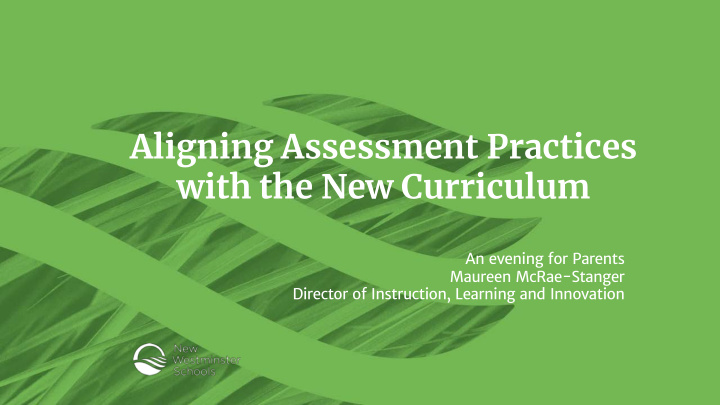



Aligning Assessment Practices with the New Curriculum An evening for Parents Maureen McRae-Stanger Director of Instruction, Learning and Innovation
Traditional Acknowledgement 2
Learning Targets PARTICIPANTS WILL BE ABLE TO: and the rationale for changes to the BC curriculum • Un Understan • Ex Explo lore e the language of assessment and the need for alignment • Un Understan • Se See how report cards are beginning to look different 3
Think, Puzzle, Explore
Ministry of Education: Why Change? Capab Capable young ung pe peopl ple thri riving ng in n a a rapi rapidly chang anging ng wo worl rld We need an educa We cation system that: better engages students in their own learning • fosters the skills and competencies they will need to succeed • Fo Focus on: personalized learning • quality teaching and learning • flexibility and choice • high standards •
The Curriculum Shift: Then and Now… 2-D: D: Know owle ledge and Skills lls 3-D: D: Understa tanding Lynn nn Ericks kson n
Curriculum Framework Co Core e Co Compet eten encies ies Le Learn rning St Standard rds
Core Competencies Co Commu mmunication Critical and Creative Th Thinking Pe Personal, Social, and Cultural 10
Big Ideas • for all students • concept based • cross grade levels • cross curricular areas • deep and enduring
Learning Standards
Aboriginal World Views/First Peoples Principles of Learning
Alignment 15
Shifting Our Practice… How I Used to Assess How I Assess Now
The Language of Assessment:
What is Assessment? Ev Evidenc ence e of stu tudent ent lea learni ning ng: • Fo Formative: e: feedback to improve learning • Sum Summativ ive : snapshot at the “end”, after lots of feedback and practice § focuses on kn know ow, do, o, understand § va varied and freq requen ent over time § stu tuden ent involved- at at c centre of process § teacher constantly ref reflect ecting/adjusting
Evaluation professional judgement of the assessment evidence; • pr based on criteria and standards • no not an n aver erage ge of sco cores es • consideration of mo most c consistent & & r recent pe performance ce level • drives teacher planning
Communicating Student Learning • co communica cation of performance ce to student/parent • fre freque uent: infor forma mal and forma formal – phone calls – student led conferences – emails – report cards… • pe perf rform rman ance lan anguag age : meeting, exceeding etc… • includes student’s ability to kn know, do and understand • includes plans for growth and im improve vement
Assessing Know, Do, and Understand Kn Know ow: co content • facts, informa fa formation on • Do: Do: sk skills s and d processe sses • “h “how w to” • Under Un erstand: appl apply an and tran ransfer r knowledge • an and skills to a a new situat ation deep, endu de during • Mo Most difficul ult to as assess=und unders rstand anding ng 21
Impact of Assessment Shifts 22
Assessment Supports from the Ministry 23
24
SHIFT from TERM to TREND Grading Term Grading : focuses reporting on the content/units Cumulative Grading: focuses reporting on covered during a specific reporting period. Each term understanding, skills, and processes in relation to reports on different content/skills and the marks for content. These understandings, skills, and processes each term are in isolation. The third or final term are taught over the entire year, not just in one term. report is typically an average of all three terms. Example: Example: Term 1 = Formative: a snapshot in time based on u Term 1: ELA Grade 3--Approaching Expectations u most recent and consistent performance of understanding and skills Term 2: ELA Grade 3--Exceeding Expectations u Term 2 = Formative: a snapshot in time based on Term 3: ELA Grade 3--Exceeding Expectations u u most recent and consistent performance of Final: ELA Grade 3: Meeting Expectations u understanding and skills Term 3 = Summative: a look back at the whole u year. The final summative progress grade assigned should be the most consistent/recent. This is referred to as “trend” reporting. 25
Shifting Reporting 26
27
28
Our Pathway….
Recommend
More recommend